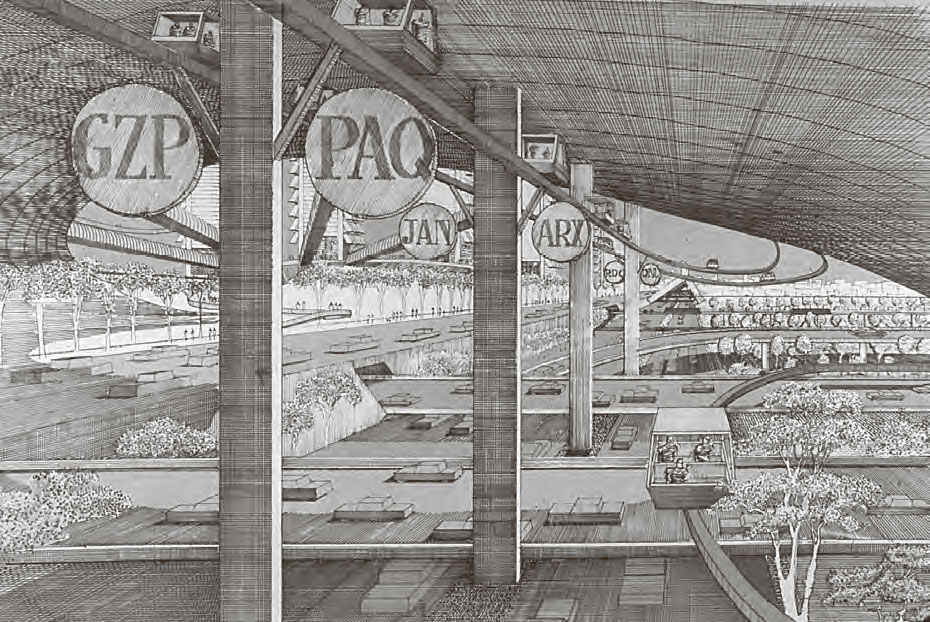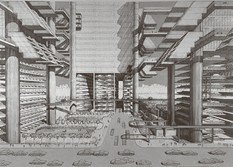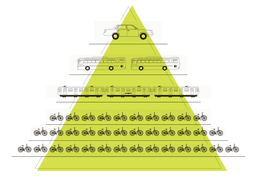Towards Sustainable Transportation
Just as Ruth Glass is often quoted in discussions on the origin of the gentrification discourse, Jane Jacobs is a symbol of breaking free from modernist fascination with the car and its presence in urban space. Her
famous reference to the need to ‘temper the automobile’ is deep-rooted in urban reality. Traffic congestion, environmental pollution and intense suburbanisation are just some of the consequences of automotive expansion into urban space1. This expansion was stimulated by modernist architects and planners, fascinated by modern technology, including the increasingly accessible cars. Due to unintended consequences of mass motoring, Jacobs’ ideas merely initiated wide-ranging changes in urban policy which were termed ‘sustainable transport’. The essence of this concept was giving priority to the most efficient and cost-effective means of transport; however, it took into account not only strictly economic issues but also the condition of areas surrounding car-dominated roads. Hence, decreasing attractiveness of a street to its users and increasing pollution or lack of space for those traffic participants who did not use cars started to be referred to as cost. Finally, it was acknowledged that the city should be considered
in a new light, abandoning the idea of extensive development and focusing on the old ideas of concise, multi-functional space where motoring would not be as indispensable as at the time of late modernism.
This postmodernist concept took roots the earliest, in the 1970s, in Western Europe. In time it also caught on in the United States, and eventually reached post-communist countries, including Poland. This happened just after the fall of communism, which is not incidental. Opening the country to Western solutions meant not only that Western political and economic concepts were transplanted into Poland but also that values characteristic of more developed societies were adopted here, as well. Sociologists refer to such processes as imitational transformation, stressing that conspicuous imitation refers to models from several stages of capitalism concurrently2. It may result in bizarre solutions that accumulate in one place and at the same time in effect of a longer and at times internally contradictory historical process. The situation is further complicated by local conditions, determined both by pre-transformation characteristics and consequences of the transformation itself. It seems crucial to realise the density of the changes involved in order to comprehend why the idea of sustainable transport propagates in Poland with such difficulty and why it is happening now.
Besides the first transport strategies of the 1990s, the pace of proliferation of the above idea in Poland was set by car expansion, similarly to the West. It happened, however, much later than in Western Europe because the car industry began to develop dynamically only after 1989. The process was further precipitated by Poland’s accession to the European Union which increased availability of relatively cheap Western vehicles that received ‘a new lease on life’ east of the Oder3. With the propagation of private car ownership, there emerged traffic problems in big cities, which became so cumbersome that it was necessary to seek remedies. Shortage of parking spaces, noise, traffic jams or pavements blocked by cars raise objections among different groups of residents not only due to actual difficulties but also in response to visual alterations of urban space. If in the first decade of Poland’s transformation it was commonly believed that transportation problems could be solved by making up for infrastructure backlog (building long-planned ring roads or inter-city roads), in the second decade this view clashed with calls to turn towards the idea of sustainable transport. According to the proponents of this approach, both activists and academics, experiences of Western European countries imply that there is no other way to solve transport problems in cities. Building new roads will not help because all it does is encourage people to use cars. Enlarging car parks in city centres is pointless because they will fill up anyway. If the mounting problem is to be solved, then, according to activists and academics, there must be a reversal of policy to show the car its place in the line, and to demonstrate that it is not necessarily (in fact, it should not be) the basic means of transport in the city because there are other, more ecological vehicles that take up less space: buses, trams, trains or bicycles. The idea of Warsaw’s Marszałkowska street as a promenade, the discussion on the layout of Mogilska street in Krakow, disputes on the layout of Poznań’s Święty Marcin street or of Kazimierza Wielkiego street in Wroclaw, and even protests against the inter-district road between Krakow’s Ruczaj housing estate and the city centre are just a few selected examples of how the concept of sustainable development has been introduced into the public discourse. However, given the context of current local authorities’ policies, the chances for this idea to catch on are really slight.
Expressway in New York of 1967-72 – a modernist city
vision prioritising car traffic (library of congress)
Culture or Structure?
Importing the concept of sustainable transport means not only voicing various demands but also showing disapproval of the present-day transport policy in Polish cities. Critics claim that it reflects tendencies long abandoned in Western Europe. Antagonists emphasise local authorities’ inconsistency towards development plans which, contrary to actual practice, adequately reflect the principles of sustainable development, even though they were often agreed at the beginning of the political transformation. In this context, critics also point out that side by side with construction projects promoting public transport, there are other projects which solidify modernist, car-oriented forms of urban space. Hence, proposals to widen city streets, build interchanges within city limits and reduce accessibility to public transport are opposed. If objections against local authorities’ policies are considered justified, there follows the question of the source of the discrepancy between transport strategies and local officials’ actual policies which hinder the implementation of transport sustainability.
Proposed justifications usually refer to the cultural sphere, viewed from the perspective of the society’s aspirations. It is notable that the Polish society remains fascinated by motoring, and the car, even if increasingly accessible, is still regarded as a status symbol. This approach to motoring should be taken into account in local policies since the authorities are as involved in the local culture as other residents but they also adjust their choices to their voters’ expectations. As a consequence, we have yet to wait for the Poles to change their attitude to motoring; it will come when the market is saturated and a car of one’s own ceases to show, just like a computer or a mobile phone, who we are and how much we have4. This line of reasoning echoes Inglehart’s transition from materialist values to postmaterialism, which, in the case of motoring, would mean a departure from the still widespread and individualised consumption towards public transport perceived as less cumbersome for urban space. The birth of social movements involved in the propagation of the idea of sustainable transport in Polish cities is given as a proof of the changes that may gradually lead the Polish society towards postmaterialism.
And yet such justifications seem unsatisfactory, even if they are obviously right. The cultural sphere must be understood in a broader sense, beyond the Poles’ (especially drivers’) view of the car as a status symbol. This approach, even if it stems from consumerist fascination with cars, is also rooted in the general image of the desired political system in Poland. A cultural justification must refer to the fascination with neoliberalism, which, Andreas Billert observes, has been popular among Polish elites ever since the start of the political transformation. Billert points out that ‘Neoliberal ideas have met (…) with an almost enthusiastic response among Polish economists, which has resulted in the implementation of a «shock therapy» and the Polish transformation model. The consequences of such an orientation and the resultant model of transformation have been felt, first and foremost, by Polish cities’5. As a result of shaping the social reality according to the liberal model, using a private car ceases to be solely a consumerist decision driven by fascination with this good. Purchasing a car of one’s own is clearly a convenience, and sometimes even a necessity preventing social exclusion. Thus, a cultural matter becomes structural and cannot simply be defined in terms of more or less conscious habits or choices made by the Poles. The decision to use a car becomes an inevitable necessity, which is well-illustrated by economic and legal determinants of both transportation policies in Polish cities (and, to be more exact, public transport organisation) and urban and suburban spatial development.
Public Transport in Retreat
The past two decades have not been favourable for public transport. Although before the political transformation it used to be the basic mode of travelling, since 1989 the situation started to change. The closure of many workplaces and gradual popularisation of private car ownership reduced the demand for employee transportation. It resulted in a limitation of the scope of transportation services offered, which in turn made public transport less attractive but decreased takings of the sale of tickets. Formed at the beginning of the transformation, local and provincial authorities bailed out stateowned public transport enterprises but only to a certain extent. Their subsidies rarely balanced increasing running costs of the existing network of connections. Moreover, the time of the rolling stock supply according to the central distribution list was over, so enterprises had to deal with bus and tram replacements on their own. Faced with financial difficulties, local governments found it increasingly difficult to meet growing demands of transport providers, and readily justified spending cuts claiming that connections were unprofitable and that in market economy public transport should be self-sustaining. In practice, it resulted in a decrease in the scope of the transport services offered, fostering the use of cars in urban space, and particularly in the environs. Above all, this policy affected those who did use public transport but were not able to make it sufficiently profitable. It could be said, therefore, that liberal policy of local governments was (and still is) a convenient way to address difficulties that are at least partly independent of local and regional authorities.
A radical free market approach to transportation issues is perceivable also when it comes to stimulating competition in the transport market. In this case liberalism in local or regional policies is a secondary effect in relation to extreme pro-market regulations at country level. Until recently, legislature enabled local governments to freely issue transport services licences to private economic subjects. Theoretically, it was supposed to foster making the offer client-friendly but in practice this approach resulted in stiff competition at the cost of security and quality of the transport services (a lack of tariff integration or even standardized and easily accessible information on schedules of various transport providers is unsurprising). Moreover, such competition focused solely on the places with major passenger streams. Less frequented routes were left up to public transport providers who struggled with restructuring and a deteriorating financial situation. The model of passenger transport organisation in Poland lacked such regulations which would allow consistent, clear and reliable transport services.
Yet even obliging local governments to organise public transport does not guarantee success in this field. There have been attempts to curb the hitherto prevailing, unrestrained market practices with a law that imposed on local and regional authorities the duty to pass transportation plans and to hold tenders on transport services meeting the needs of residents of communes, districts and provinces. In practice, when new regulations first entered into force, it led to disagreements between the former transport providers and local governments, instead of putting the situation in order and enabling systematic financing of transport services. The former demanded that the local governments should subsidise them under the present legal regulations. The latter were unwilling to reach to local or regional budgets since they were half-empty and, as it was mentioned above, it would be preferable if private transport financed itself (at least largely) independently.
In the context of such difficulties public transport was becoming decreasingly versatile to potential clients, and at times disappeared completely from city environs, forcing former passengers to cope on their own or to get to nearby localities. In this situation a private car was indispensable, as the Polish General Social Survey results clearly illustrate. They reveal that the farther a locality is from cities, the greater the number of cars, regardless of their users’ income. In suburbs the car is not a privilege. It has become a necessity in daily life without which doing errands would be next to impossible. Satisfying daily needs does not happen in a vacuum and usually entails driving to nearby cities. That in turn increases congestion in cities which municipal authorities find increasingly difficult to cope with.
Spatial Eldorado
Difficulties in organising and financing public transport stem not only from liberalminded local and regional elites’ professed preference for self-sufficiency when called to increase expenditure on transport out of emptyish local government budgets. They are also the aftermath of equally liberal spatial planning, determined by country regulations. This issue is discussed at length by above mentioned Andreas Billert who points out that Polish legislature allows chaotic property development, welcomed by local governments which do not impose any requirements on investors. The lack of a broader urban planning vision results not only in building housing estates devoid of proper infrastructure but also leads to uncontrolled and unregulated suburban sprawl. Buildings are erected in places that are not prepared for it, which entails, Katarzyna Kajdanek argues in her book on Polish suburbia, continual shifting of responsibility for infrastructure between local authorities and new residents in suburbs6. These conflicts are not surprising, given that chaotically developed suburbs and outskirts of cities generate considerable infrastructure costs. The present model of spatial development is a hindrance for a policy that might reduce the share of private cars in the total number of travels in cities. Moreover, the model hampers redefining the policy in terms of new road infrastructure, which is one of the key demands of the supporters of the idea of sustainable transport. It is hardly feasible to reduce capital expenditure on roads when new housing estates are constructed in the middle of nowhere, at a considerable distance from existing infrastructure and without a broader urban planning vision. Suburbia can hardly be served by public transport, especially when it is expected to be self-sufficient. Low population density raises the cost of public transport services in these areas to hardly acceptable levels even in highly developed countries7, and in the case of Poland the situation is worsened by the above mentioned spatial chaos.
Squeezed Between Thoroughfares
Chaotically developed and sprawling cities are just one of the reasons why ever since the beginning of the transformation extending road infrastructure has been the top priority of local governments. Other reasons include a disastrous condition of city streets8, and investment backlog with regard to the preparation of the target road layout in Polish cities. Attempts to implement long-devised plans are understandable, particularly since they are fostered by the availability of EU funding which, paradoxically, comes from a place where the idea of sustainable transport originated and was eagerly embraced. Polish local governments’ policies should not raise any doubts given that many Polish cities still lack ring roads taking transit traffic away from centres, where congestion is rising, and the majority of roads require immediate repairs. Street construction or modernisation raises hopes that the road network throughput will increase and cumbersome traffic jams will be cleared. This policy is criticized, however, by supporters of the idea of sustainable transport who point out that there is also a psychological aspect to extending infrastructure. With improved travel quality, people are encouraged to use cars, which in turn stimulates traffic growth, and thus transport difficulties recur9. Proponents of the idea of sustainable transport claim that this vicious circle, also called the transport black hole10, can be broken by promoting alternative forms of transport and abandoning the concept of extending road corridors. Still, preference for public transport at the cost of road extension and modernisation is rather challenging in view of modest budgets, regulations fostering thoughtless spatial development or noticeable infrastructure backlog, all of which are disapproved by the society still fascinated with motoring.
If there is to be any sustained development, it must be in the sense of parallel implementation of old and new models. The question of transport is a perfect example of imitational transformation: propagation of individual car ownership and of the opposing idea of sustainable transport take place simultaneously in Poland, even if the process took much longer in Western Europe. There is still a long way to go to achieve transport sustainability because local authorities’ policies do not involve analyses of the potential of various means of transport or promoting those that would prove to be the most cost-eff ective, effi cient and least cumbersome to the surroundings11. Instead, it is marked by defensive attempts to attract all sorts of voters: both pro-car and postmodernist ones. Modernist models still fare well, and are set to stay for several upcoming decades, as some postmodernists believe. Overshadowed by attempts to make up for infrastructure backlog and provide road networks in the suburbs, against the background of liberal discourse on spatial development and public transport funding, the car is to strengthen its dominance, tempting Poles and off ering what alternative means of transport cannot do, or, even if they can, they do so in quasi-attractive and unsatisfactory ways.












